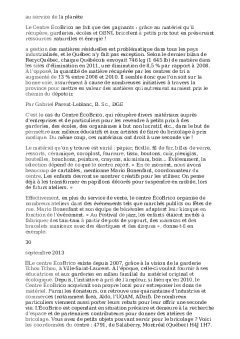Seerat rani f2019231060 biochem lab
University of Management and Technology Name Seerat Rani ID F Section A Submitted To Sir Muhammad Khurram Topic CRISPER Cas Gene Editing CWrite a summary CRISPER Cas Gene Editing CRISPR Cas a genome editing technology derived from a bacterial innate immune system found in variety of bacteria and archaea are fragments of prokaryotic DNA containing short repetitions of base sequences Jiang Doudna CRISPR Cas involves two essential components a guide RNA called synthetic single guide RNA sgRNA is the section of RNA which binds to the genomic DNA of ?? nucleotides to match a desired target gene and Cas CRISPR-associated protein Redman et al an RNA-guided endonuclease from microbial adaptive immune system clustered regularly interspaced short palindromic repeats CRISPR which causes a double- stranded DNA break allowing modi ?cations to the genome It makes it possible to correct errors in the genome and turn on or o ? genes in cells and organisms quickly cheaply and with relative ease Yusof The CRISPR array is made up of an AT-rich leader sequence followed by short repeats that are separated by unique spacers CRISPR repeats typically range in size from to base pairs bps Some show dyad symmetry implying the formation of a secondary structure such as a stem-loop 'hairpin' in the RNA CRISPR-Cas systems have two classes Class systems use a complex of multiple Cas proteins to degrade foreign nucleic acids Class systems use a single large CAS protein for the same purpose Cas features a bi-lobed architecture with the guide RNA nestled between the alpha-helical lobe and the nuclease lobe These two lobes are connected through a single bridge helix Bannikov Lavrov There are two nuclease domains located in the multi-domain nuclease lobe the RuvC which cleaves the non-target DNA strand and the HNH nuclease domain that cleaves the target strand of DNA The RuvC domain is encoded by sequentially disparate sites that interact in the tertiary structure to form the RuvC cleavage domain A key feature of the target DNA is that it must contain a protospacer adjacent motif PAM consisting of the three-nucleotide sequence- NGG Jiang Doudna Adaptive immunity occurs in three stages i insertion of a short sequence of the invading DNA into the CRISPR array as a spacer sequence ii transcription of precursor CRISPR RNA pre-crRNA which goes through maturation to yield individual crRNAs each composed of a repeat portion and an invader-targeting spacer portion iii crRNA-directed cleavage of foreign nucleic acid because of Cas proteins at sites complementary to crRNA spacer sequence Three di ?erent types of CRISPR Cas system had been identi ?ed Type I II and III that utilizes di ?erent mechanism in generating CRISPR RNA crRNA and CAS proteins For the purpose of genome editing researchers Redman et al adapted the Type II system based on its Csimplicity in requiring only CRISPR-associated protein Cas proteins from Streptococcus progenes and two other RNA components crRNA and trans-activating crRNA tracrRNA that fused to become guide RNA gRNA Hille Charpentier In this system the tracrRNA
Documents similaires










-
65
-
0
-
0
Licence et utilisation
Gratuit pour un usage personnel Attribution requise- Détails
- Publié le Aoû 18, 2022
- Catégorie Creative Arts / Ar...
- Langue French
- Taille du fichier 47.2kB


